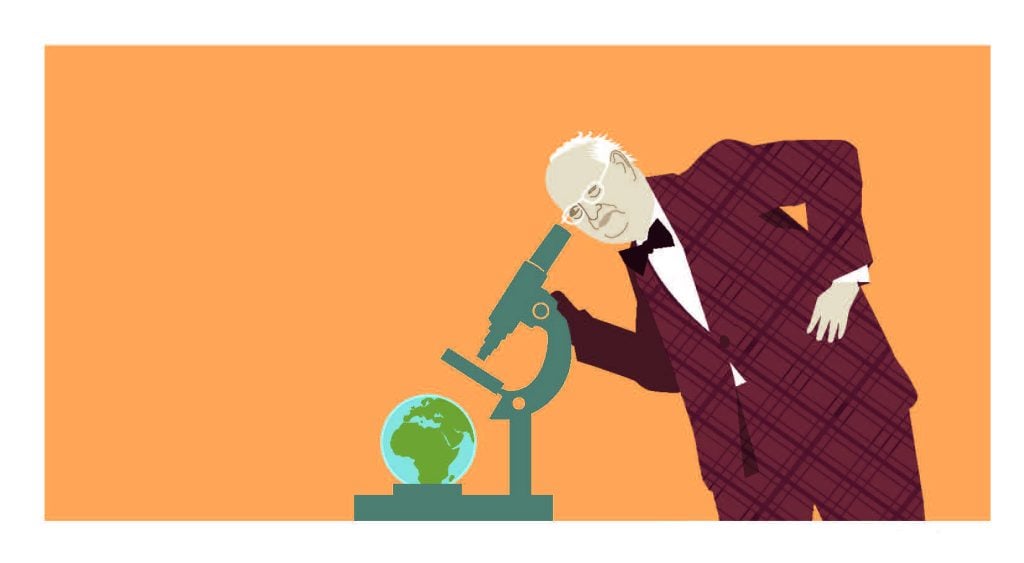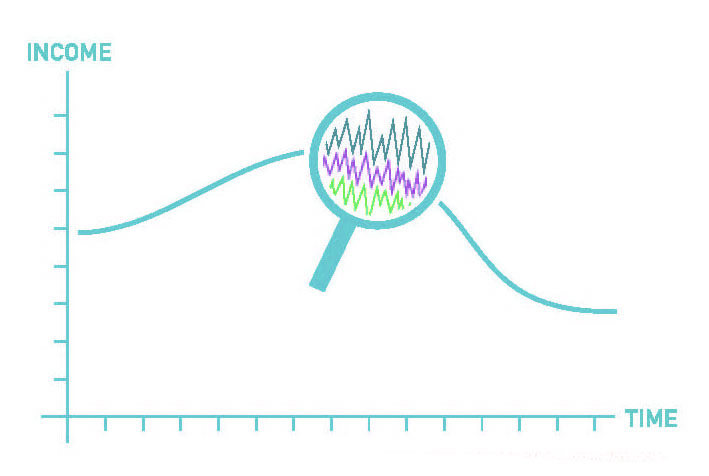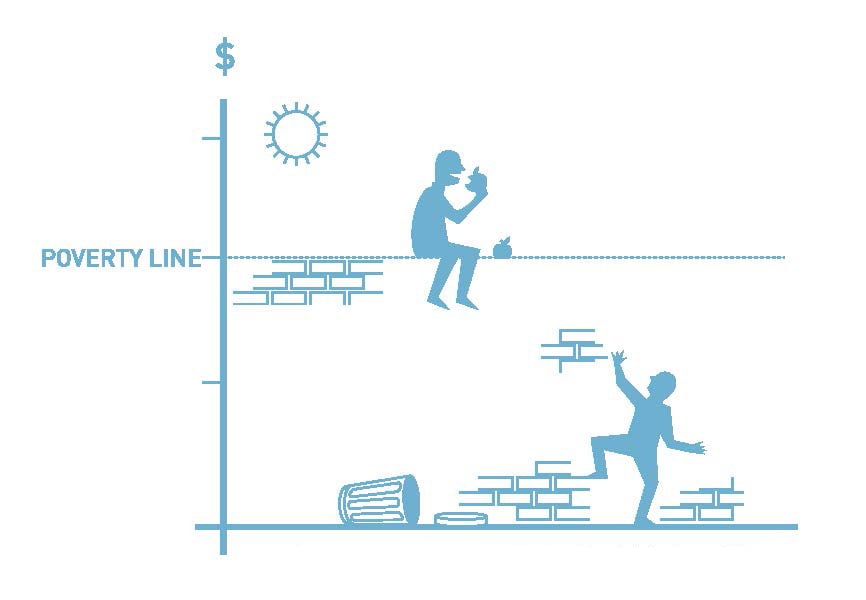Popular information
Popular science background:
Consumption, great and small (pdf)
Populärvetenskaplig information:
Konsumtion i stort och smått (pdf)

The Prize in Economic Sciences 2015
The consumption of goods and services is a fundamental part of people’s welfare. The Laureate, Angus Deaton, has deepened our understanding of different aspects of consumption. His research concerns issues of immense importance for human welfare, not least in poor countries. Deaton’s research has greatly influenced both practical policymaking and the scientific community. By emphasizing the links between individual consumption decisions and outcomes for the whole economy, his work has helped transform modern microeconomics, macroeconomics and development economics.
Consumption, great and small

Deaton receives this year’s Prize in Economic Sciences for three related achievements: the system for estimating the demand for different goods that he and John Muellbauer developed around 1980; the studies of the link between consumption and income that he conducted around 1990; and the work he has carried out in later decades on measuring living standards and poverty in developing countries with the help of household surveys.
Demand systems and microeconomics
A demand system is a set of equations that show the level of consumer demand for different goods and services: one equation may refer to the demand for clothes, another the demand for food, etc. Each of these equations shows how the demand for that particular good varies with the prices of all goods, consumer incomes and demographic factors. Such a system is useful for making decisions on economic policy. For example, if the government wants to increase VAT on food, or reduce income tax for a specific group, it is vital to know how such a reform will affect the consumption of various goods and which social groups will gain or lose.
When a researcher confronts a demand system with data, the system should fulfil a number of requirements in order to be reliable and useful. Of course, this system has to fit well with the patterns observed in the data. In order to calculate meaningful welfare effects, it should also be compatible with the theory of rational consumers. During the 1960s and 1970s, a number of economists had tested existing demand systems and found that they did not accurately predict how demand varied with prices and incomes, nor did they appear to be consistent with the presumption of rational consumers. The explanation for the latter could of course be that consumers are not completely rational. However, Deaton demonstrated that the existing systems were more narrowly constructed than had previously been thought; they forced consumer behavior into a straitjacket of assumptions that was too restrictive to realistically reflect actual consumer choice.
The challenge was to build a system that was sufficiently general to provide a reliable picture of demand patterns in society, but also simple enough to be statistically estimated and used. The solution was Deaton and Muellbauer’s Almost Ideal Demand System from 1980. Their first estimates based on this system did not provide clear answers to all the questions surrounding consumption, but the system’s flexibility and potential for expansion and modification provided a powerful boost to research into consumer behaviour.
After 35 years, Deaton and Muellbauer’s demand system, and the improvements upon it by other researchers, remain standard tools for studying the effects of economic policy, for constructing price indexes, and for comparing living standards across countries and time periods. In other words, it has had an immense impact in academia, as well as being greatly influential in practical policy evaluation.
Consumption, income and macroeconomics
The Almost Ideal Demand System describes how households distribute their consumption among various goods in a specific time period, given their total expenditures in the period. However, their total expenditures are not given, as they are decided by the households themselves when they plan their consumption from year to year. So how much of their incomes do people consume in various time periods? This is an important issue in macroeconomics – the flip side of total consumption is total saving, and the evolution of savings over time in a country is important to its capital formation and business cycles.
The 1950s saw the development of two well-known theories for how consumption, and thus saving, depend on the development of income: Milton Friedman’s Permanent Income Hypothesis and Franco Modigliani’s analogous Life-Cycle Model. The core implication of these theories is that individuals want to smooth their consumption over time. They save when they expect lower future incomes and borrow in the opposite circumstances. These two theories, in the formulation they received in the 1970s, came to play a major role in macroeconomic research. In several articles around 1990, Deaton and his co-authors tested a number of important implications deduced from the Permanent Income Hypothesis. These tests would come to change the basic view of the links between theory and data.
At this time, almost all macroeconomic research was based on the notion of a “representative consumer”, whose consumption varied along with society’s aggregate or mean income. With this simplified assumption, Deaton was able to demonstrate that the Permanent Income Hypothesis predicts that consumption will vary more than income. This is the case because an unanticipated increase in income for the whole economy tends to be followed by additional income hikes in subsequent years. A rational representative consumer should therefore consume some of these expected income hikes before they happen, which means that current consumption should go up by more than current income. Because this contradicts the patterns in aggregate data, where consumption varies less than income, Deaton’s finding put the whole theory in doubt. This apparent contradiction between theory and data became known as the Deaton Paradox.
Deaton showed that the key to resolving this paradox – and a better understanding of macroeconomic data more generally – is to study the income and consumption of individuals, whose incomes fluctuate in an entirely different way to the average income. Since the incomes of some people decrease at the ame time as the incomes of others increase, the bulk of individual variations in income average out when we compute the representative consumer’s income. By pinning down how individual consumption levels vary with individual income levels before consumption is aggregated, the predictions of the theory come much closer to the patterns we observe in aggregate data, especially if we take into account that individuals face constraints when financing their desired consumption through borrowing.

Deaton also showed that when we study individual data, the standard theory has additional predictions, which others had not seen. For example, the distribution of consumption across all individuals in a generation fans out as individuals get older, a prediction that has also proven true in reality. The extent of this fanning out can be used to assess to what extent individuals can insure themselves against shocks to their own incomes.
The insights provided by Deaton’s work on consumption and income have had a lasting influence on modern macroeconomic research. Previous researchers in macroeconomics, from Keynes onwards, had relied only on aggregate data. Even if their purpose is to understand relationships at a macro level, today’s researchers usually start at the individual level and then, with great caution, add together individual behaviors to compute numbers for the entire economy.
Household data and development economics
In recent decades, Angus Deaton has conducted extensive research into consumption and poverty in developing countries, using his insights into demand systems and individual consumption over time. He has emphasized the importance of building up extensive data sets with household consumption of different goods, as consumption data in developing countries is often more reliable and useful than income data. Deaton has also shown how such data can be used to measure and understand poverty and its determinants.
One problem that arises when studying consumption and its determinants is which type of consumption data to collect. Panel data – data for an unchanged sample of households, year after year – may in principle be preferable for studying consumption patterns, but such data also have specific problems, such as systematic withdrawal from the panel. Deaton showed that repeated collection of cross-sectional data – where cohorts rather than individual households are tracked over time – is not only simpler and cheaper, but in many cases preferable.
Another problem is how to measure the extent of poverty from consumption or expenditure data when households in different places face different local prices, or when they consume different types of goods and neither the price nor the quality of the goods are directly observable. In research that has had a great impact on poverty measurement in developing countries, Deaton has shown how to exploit variation in unit values (expenditure divided quantity) to construct local market prices when these are not available.
Yet another problem is that poverty is naturally defined at the individual level, whereas consumption data is normally collected at the household level. The most common approach is to measure individual welfare by total household expenditures per capita, which assumes that a child consumes as much as an adult.
However, Deaton has shown that a more reasonable estimate of expenditure for a child is 30-40 percent of that for an adult. Per-capita estimates of poverty will therefore overstate the extent of poverty among households with children.
Deaton has also made a number of important contributions to the best ways to compare welfare across time and countries. He has highlighted the pitfalls of such comparisons by investigating why measures of poverty levels point in one direction when using data from national accounts, and in another direction when using data from household surveys. He has also clarified why recent revisions to the poverty line that defines a poor family have increased the global poverty count by nearly half a billion.

In the 1980s, research into economic development was mostly theoretical and, where it was empirical, it was based on aggregate data from national accounts. This has now changed. Development economics is a flourishing empirical research field based upon the advanced analysis of detailed data from individual households. Deaton’s research has been an important driving force in this transformation. Two examples – both based on solid analysis of household consumption – illustrate his influence.
For a long time, economists have labored with the idea that a country may become stuck in a poverty trap. Low incomes can result in such low calorie intake that people cannot work at full capacity – thus their incomes remain low, and so does their calorie intake. The question of poverty traps is important in designing international assistance to the poorest countries. If assistance is geared towards encouraging economic growth, but increasing income still does not lead to noticeably increased calorie intake, there is an argument for reorienting assistance towards direct food aid. Deaton’s research on the relationship between income and calorie intake has shed important light on this issue: increased income does indeed lead to more calories being consumed. On the other hand, the evidence does not support the hypothesis that malnutrition explains poverty. In other words, malnutrition is largely the consequence of a low income, not vice versa. Another example is Deaton’s work on gender discrimination within the family. While there is much evidence that sons are favored over daughters in many developing countries – the phenomenon of “missing women” perhaps being the starkest example – the mechanisms through which discrimination comes about are unclear. One mechanism may be that daughters are systematically given fewer resources than sons, but testing this is difficult. Even if it were possible to have researchers living with many different families for every hour of the day to observe their consumption choices, households may change behavior while being observed. To overcome this measurement problem, Deaton proposed an ingenious way of using household consumption data to indirectly estimate whether daughters are given less than sons. Specifically, Deaton investigated whether the consumption of adult goods (like adult clothes, tobacco, or alcohol) diminishes when the family has children, and whether this reduction is greater when the child is a boy rather than a girl. Using household surveys from several developing countries, Deaton was not able to find any systematic differences under normal circumstances. Later work, however, has shown evidence of clear discrimination when households face adverse circumstances.
Broad contributions and bridge-building
Angus Deaton’s research spans a very broad field, touching on many different aspects of consumption. It also shows an impressive breadth in its approaches: basic theory; statistical methods for testing theories; in-depth knowledge of the quality of existing data; and extensive work on producing new kinds of data. One common denominator in his research is the desire to build bridges between theory and data.
Another common denominator is building bridges between individual behaviors and aggregate economic outcomes. Angus Deaton’s many contributions have left clear and lasting impressions in practical economic policy and in modern economic research.
Links and further reading
Autobiographical article
Deaton, A. (2011) Puzzles and Paradoxes: A Life in Applied Economics.
https://www.princeton.edu/~deaton/downloads/deaton_puzzles_and_ paradoxes_v1_5_11_17_11.pdf
Lectures (video)
Deaton, A. (2014-12-09) A Menagerie of Lines: How to Decide Who is Poor? London School of Economics and Political Sciences, UK.
https://www.youtube.com/watch?v=rb0iGi8K3AY
Deaton, A. (2012-09-04) Wellbeing Nobel Symposium: Growth and Development, Institute for International Economic Studies (IIES), Stockholm University.
http://www.ur.se/index.php/Produkter/172262-UR-Samtiden-Nobelsymposium-Tillvaxt-och-utveckling-Valbefinnande
Scientific books
Deaton, A., Muellbauer, J. (1980) Economics and Consumer Behavior, Cambridge University Press,
Cambridge, UK.
Deaton, A. (1992) Understanding Consumption, Oxford University Press, Oxford, UK.
Deaton, A. (1997) The Analysis of Household Surveys: A Microeconomic Approach to Development Policy, John Hopkins University Press, Baltimore, MD, USA.
The Laureate
ANGUS DEATON
UK and US citizen. Born 1945 in Edinburgh, UK. Ph.D. 1974 from University of Cambridge, UK. Professor of Economics and International Affairs, Princeton University, NJ, USA, since 1983.
http://scholar.princeton.edu/deaton
